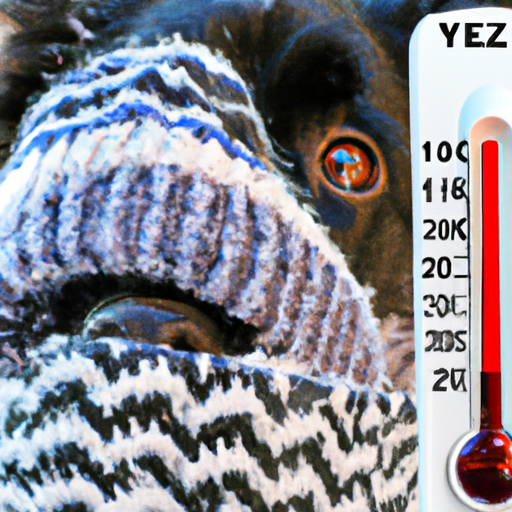Imagine stepping out into a blizzard, barefoot and without proper winter attire. You’d shiver uncontrollably, your teeth would chatter, and within minutes you’d feel the painful sting of frostbite creeping into your fingers and toes.
Now consider how your dog might feel in the same scenario. Just like us, dogs are susceptible to hypothermia and frostbite when exposed to extremely cold temperatures for prolonged periods.
While some breeds are more resistant to harsh winter conditions than others due to their thick fur coats or fat reserves, all dogs can potentially suffer from cold-related health issues if not properly cared for during winter months.
Recognizing signs of distress in your pet such as shivering or sudden lethargy is crucial in preventing severe complications like hypothermia. Ensuring that they have appropriate winter apparel and taking certain precautions with their care can also play a critical role in keeping them safe and comfortable throughout the chilliest season of the year.
Understanding Hypothermia in Canines
Imagine you’re out with your pup on a frigid winter day, the wind nipping at your noses. It’s crucial to understand that dogs can actually develop hypothermia, just like us humans. Hypothermia in canines occurs when their body temperature drops significantly below the normal range due to inadequate thermoregulation mechanisms.
While dogs have a fur coat designed for insulation and protection against extreme weather conditions, it doesn’t necessarily mean they’re immune to cold weather effects. Factors such as age, overall health status, and breed type can affect how efficiently these thermoregulation mechanisms work.
If you suspect canine hypothermia onset in your pet dog, immediate treatment is critical. Canine hypothermia treatment includes gradually warming up the dog’s body using methods like blankets or warm water bottles – but never hot water or heat sources that could cause burns.
It’s best to take them straight to a vet if possible, where they have access to professional medical care, including intravenous fluids and oxygen therapy if required. Remember that prevention is always better than cure. Ensure your furry friend is sufficiently protected from excessive cold exposure, especially during those icy winter walks.
Breed-Specific Tolerance to Low Temperatures
You’d be surprised to learn how much a canine’s tolerance to chilly weather varies based on their breed. Breed sensitivity to low temperatures is significant among dogs, with certain breeds having been developed in climates that demanded high temperature adaptability.
For instance, breeds such as the Siberian Husky or Alaskan Malamute boast dense fur and robust metabolism, equipping them for frigid conditions. Conversely, smaller breeds like Chihuahuas or Whippets have less body mass and thin coats making them more susceptible to cold.
It’s crucial to remember that while some breeds are inherently better equipped for colder environments due to their physical traits and genetic predispositions, this doesn’t negate the necessity of appropriate care during winter months. Factors such as age, size, health status also play a role in determining a dog’s ability to withstand cold temperatures.
Regular vet check-ups can help you understand your pet’s specific needs and ensure they’re adequately protected from potential health risks associated with extreme cold.
Recognizing Signs of Frostbite in Your Pet
Spotting signs of frostbite in your pet can be as tricky as finding a snowflake in a blizzard, but it’s essential to keep an eye out for any unusual changes. Just as you might feel discomfort or numbness in your fingertips after building a long-lasting snowman, your pet may exhibit similar symptoms if they’ve been exposed to freezing temperatures for extended periods.
The onset of frostbite is often subtle; however, some common indicators that your dog could be suffering from this cold weather injury include:
– Discoloration of the skin: This could range from pale or blue to dark red, indicating damage.
– Swelling or blistering: If your pet’s skin appears swollen or develops blisters, this could be a sign.
– Pain or sensitivity: Your dog may show signs of discomfort when the affected area is touched.
The key to dealing with potential frostbite lies in Frostbite Prevention and knowing the right Treatment Options. As soon as you notice any symptoms, wrap them up warmly and take them indoors immediately. Avoid applying direct heat like hot water or heating pads since these can cause more harm than good. Instead, use warm (not hot) water and blankets slowly raise their body temperature.
Contacting a veterinarian should be done promptly for professional advice on pain management and further treatment options because untreated frostbite can lead to serious complications such as infection or even tissue necrosis. Remember that prevention is always better than cure; keeping your furry friend warm during cold weather conditions should always be your top priority!
Proper Winter Care for Your Dog
When chilly winds start to blow and snowflakes begin to fall, it’s time to think about how you’re going to ensure your pup stays snug and healthy throughout the winter months.
One of the first things you should consider is dietary adjustments. Just like humans, dogs need a bit more fuel in the colder weather, so increasing their food intake may be necessary. However, this doesn’t mean piling on extra kibble without thought. Consult with your vet about the best way to adjust your dog’s diet during winter, taking into account their age, size, breed, and overall health condition.
In addition to dietary changes, indoor exercises are crucial as they help keep your canine companion active when outdoor activities are limited due to harsh weather conditions. You can play hide-and-seek with treats or toys around the house or invest in interactive dog toys that’ll stimulate both their mind and body.
Treadmill exercises may also be an option if your pet is accustomed to it, but always remember safety comes first. Regular exercise will not only help maintain your dog’s physical health but also ward off any potential winter blues from being cooped up inside for too long.
Winter Apparel for Your Four-Legged Friend
Just as you’d bundle up in a cozy sweater to brave the winter chill, your furry friend might also appreciate some extra warmth. Indeed, when temperatures dip below freezing, your dog can be at risk of hypothermia and frostbite, especially if they’re a small breed or have short fur. That’s where winter apparel comes into play!
Puppy parkas are an excellent choice for your four-legged pal. Made with insulating materials and often featuring a water-resistant outer layer, these items can offer your pup substantial protection against the cold.
Not only is their body susceptible to cold weather but their paws too. The skin on their paw pads can crack and bleed due to icy conditions or from the harsh chemicals used in road salts. Doggie boots provide an effective solution here. These boots create a barrier between harmful elements and your dog’s sensitive paws while also providing added traction on slippery surfaces. Remember that not all dogs will take kindly to wearing shoes right away; it may take time for them to adjust so be patient and rewarding during this process!
Ensuring our pets are properly outfitted for winter weather is crucial for their health and happiness throughout the season.
Frequently Asked Questions
What is the impact of a dog’s age on their ability to withstand cold temperatures?”
“Age-related illnesses can hinder your dog’s ability to withstand cold temperatures. Senior dog care often requires extra warmth as older dogs have less fat and muscle mass, reducing their natural insulation against the cold.”
Does the size of the dog affect its ability to handle cold weather?”
Like Goldilocks searching for the perfect porridge, your dog’s size does matter when handling cold. Larger breeds can withstand cooler temperatures better due to breed susceptibility and coat thickness, but always monitor for discomfort.
What specific types of food or nutrients can help my dog stay warm during the winter months?”
Feeding your dog high-quality proteins and fats can boost their metabolism, helping them stay warm. Additionally, consider providing warming dog beds and homemade dog sweaters for extra comfort during the colder months.
Are there any indoor exercises I can do with my dog during extremely cold days?”
Sure, you’re not training for the Doggy Olympics, but indoor agility courses and interactive games can keep Fido fit when it’s too chilly for walks. It’s fun, engaging and promotes overall canine health.
How can I prevent my dog from slipping on ice during winter walks?”
To prevent your dog from slipping on ice during winter walks, consider paw protection options like booties or wax. Invest in appropriate winter dog gear that provides grip and safeguards their paws against icy surfaces.
Conclusion
Remember, every dog is different and what’s too cold for one might be just right for another. Don’t throw caution to the wind when it comes to your pet’s health in chilly weather. Always keep an eye out for signs of frostbite or hypothermia and make sure they’re properly kitted out in winter gear if needed.
In the end, it’s all about keeping your furry friend safe and comfortable. With proper care, you can ensure that even on the coldest days, your pooch doesn’t freeze his tail off!



